2016中考王英语中考命题研究(遵义)专题研究突破:专题八动词(练习无答案)
文档属性
| 名称 | 2016中考王英语中考命题研究(遵义)专题研究突破:专题八动词(练习无答案) | 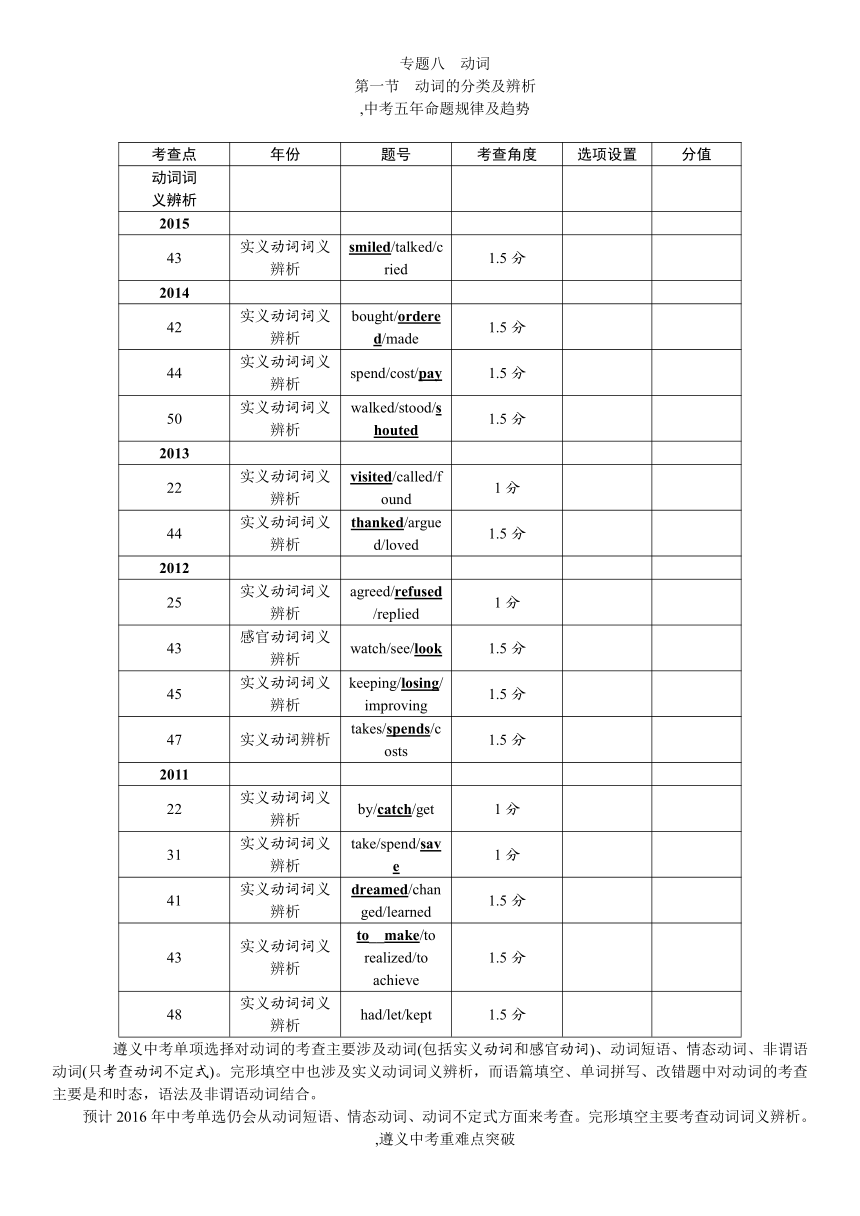 | |
| 格式 | zip | ||
| 文件大小 | 111.5KB | ||
| 资源类型 | 教案 | ||
| 版本资源 | 通用版 | ||
| 科目 | 英语 | ||
| 更新时间 | 2016-04-17 07:32:54 | ||
图片预览

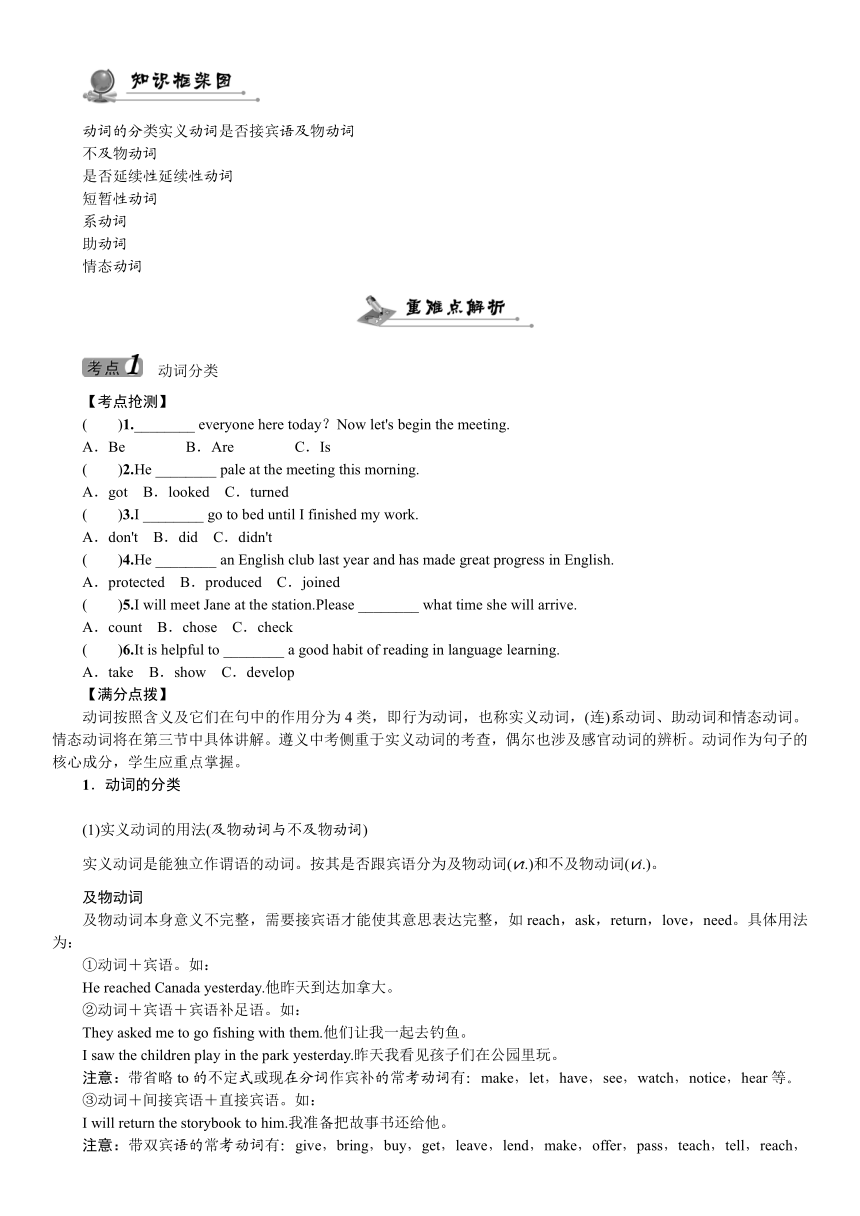
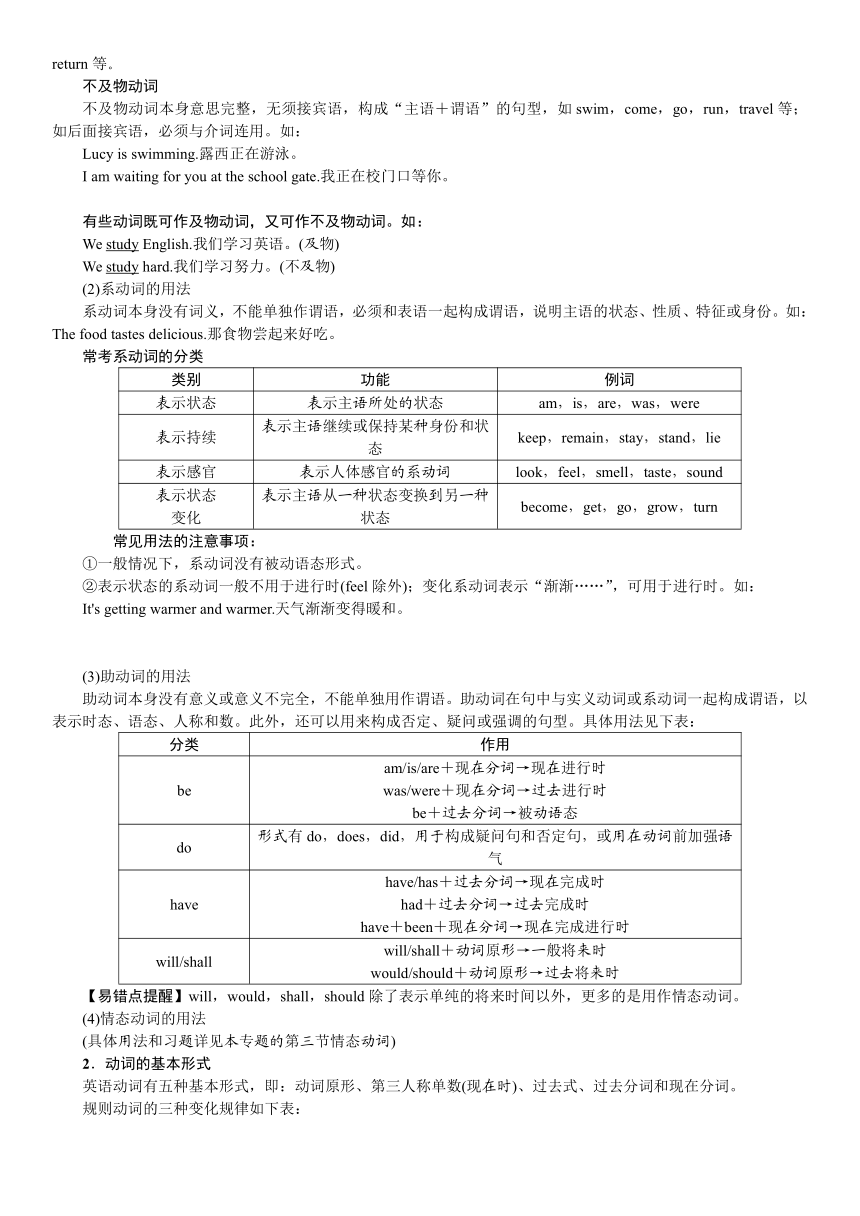
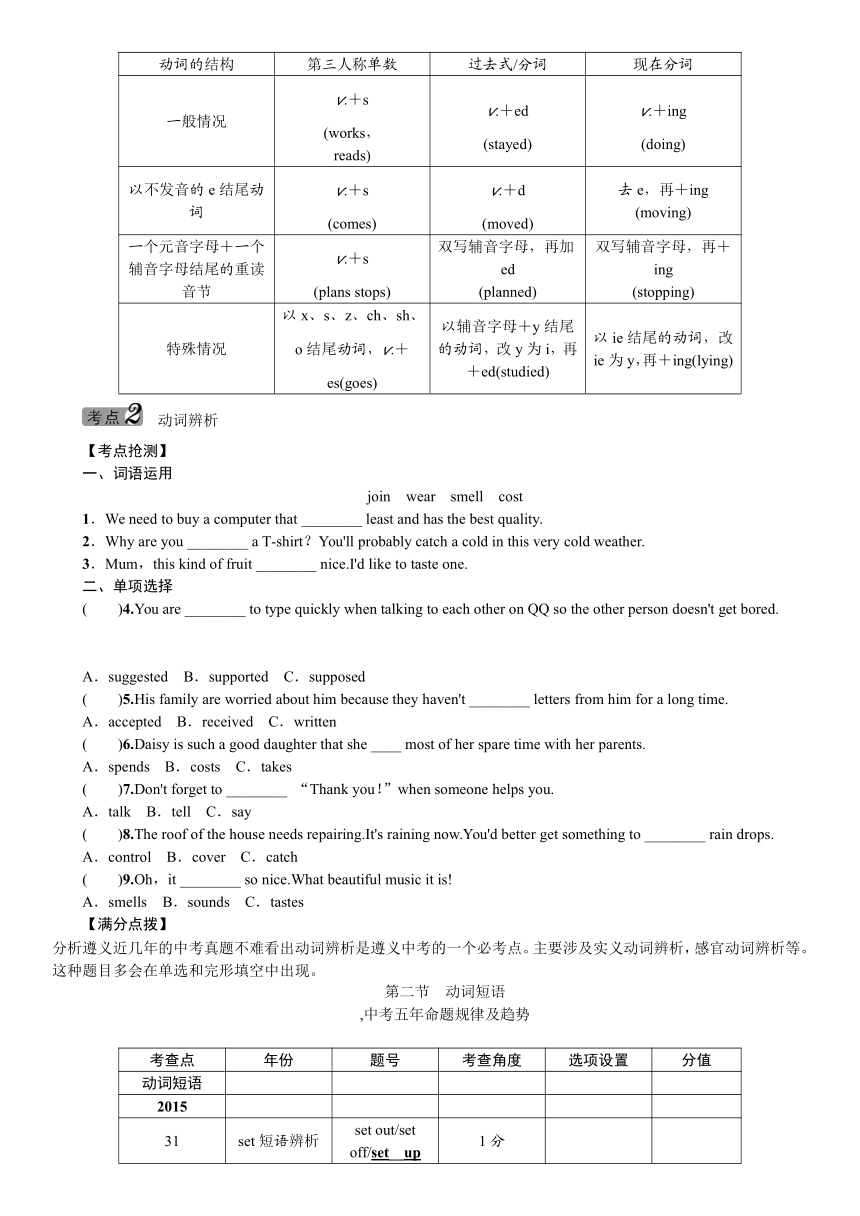
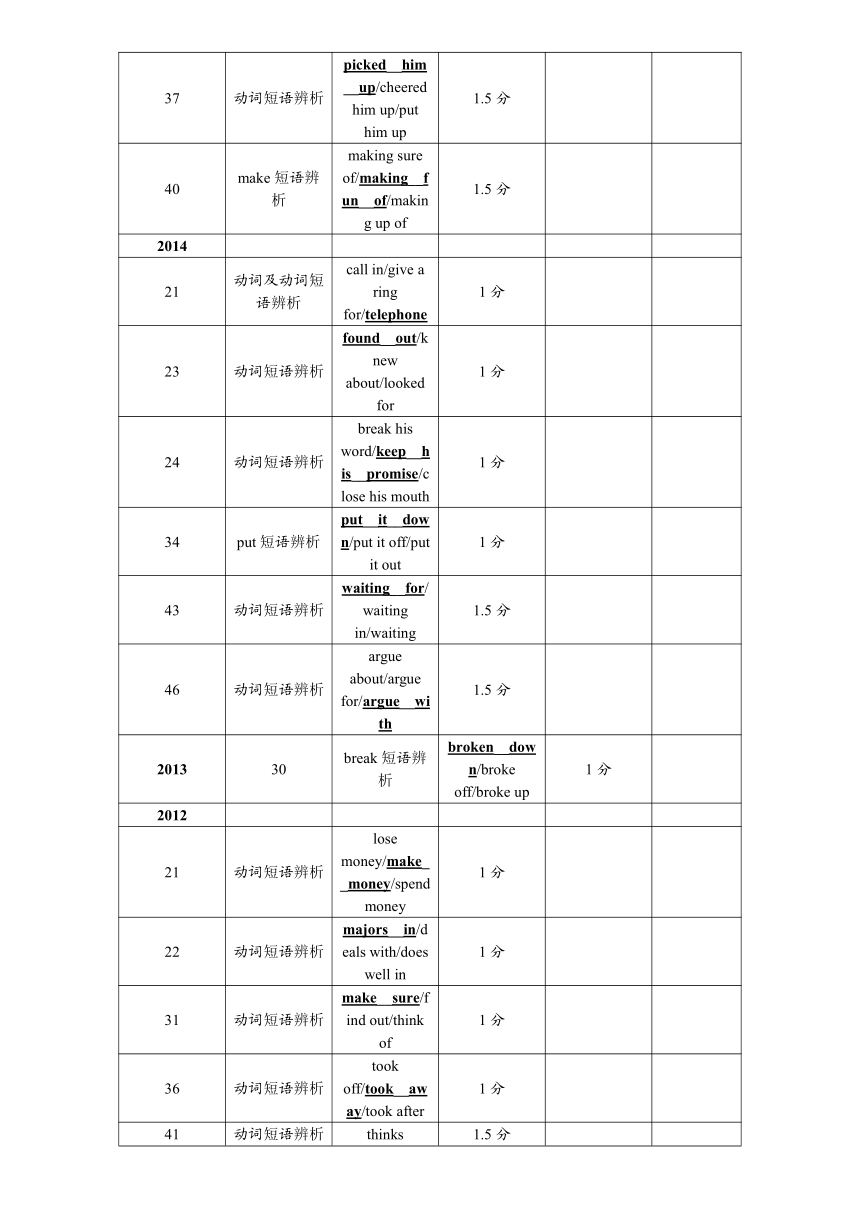
文档简介
专题八 动词
第一节 动词的分类及辨析
,中考五年命题规律及趋势
考查点
年份
题号
考查角度
选项设置
分值
动词词
义辨析
2015
43
实义动词词义辨析
smiled/talked/cried
1.5分
2014
42
实义动词词义辨析
bought/ordered/made
1.5分
44
实义动词词义辨析
spend/cost/pay
1.5分
50
实义动词词义辨析
walked/stood/shouted
1.5分
2013
22
实义动词词义辨析
visited/called/found
1分
44
实义动词词义辨析
thanked/argued/loved
1.5分
2012
25
实义动词词义辨析
agreed/refused/replied
1分
43
感官动词词义辨析
watch/see/look
1.5分
45
实义动词词义辨析
keeping/losing/improving
1.5分
47
实义动词辨析
takes/spends/costs
1.5分
2011
22
实义动词词义辨析
by/catch/get
1分
31
实义动词词义辨析
take/spend/save
1分
41
实义动词词义辨析
dreamed/changed/learned
1.5分
43
实义动词词义辨析
to__make/to realized/to achieve
1.5分
48
实义动词词义辨析
had/let/kept
1.5分
遵义中考单项选择对动词的考查主要涉及动词(包括实义动词和感官动词)、动词短语、情态动词、非谓语动词(只考查动词不定式)。完形填空中也涉及实义动词词义辨析,而语篇填空、单词拼写、改错题中对动词的考查主要是和时态,语法及非谓语动词结合。
预计2016年中考单选仍会从动词短语、情态动词、动词不定式方面来考查。完形填空主要考查动词词义辨析。
,遵义中考重难点突破
动词的分类实义动词是否接宾语及物动词
不及物动词
是否延续性延续性动词
短暂性动词
系动词
助动词
情态动词
动词分类
【考点抢测】
( )1.________ everyone here today?Now let's begin the meeting.
A.Be B.Are C.Is
( )2.He ________ pale at the meeting this morning.
A.got B.looked C.turned
( )3.I ________ go to bed until I finished my work.
A.don't B.did C.didn't
( )4.He ________ an English club last year and has made great progress in English.
A.protected B.produced C.joined
( )5.I will meet Jane at the station.Please ________ what time she will arrive.
A.count B.chose C.check
( )6.It is helpful to ________ a good habit of reading in language learning.
A.take B.show C.develop
【满分点拨】
动词按照含义及它们在句中的作用分为4类,即行为动词,也称实义动词,(连)系动词、助动词和情态动词。情态动词将在第三节中具体讲解。遵义中考侧重于实义动词的考查,偶尔也涉及感官动词的辨析。动词作为句子的核心成分,学生应重点掌握。
1.动词的分类
(1)实义动词的用法(及物动词与不及物动词)
实义动词是能独立作谓语的动词。按其是否跟宾语分为及物动词(vt.)和不及物动词(vi.)。
及物动词
及物动词本身意义不完整,需要接宾语才能使其意思表达完整,如reach,ask,return,love,need。具体用法为:
①动词+宾语。如:
He reached Canada yesterday.他昨天到达加拿大。
②动词+宾语+宾语补足语。如:
They asked me to go fishing with them.他们让我一起去钓鱼。
I saw the children play in the park yesterday.昨天我看见孩子们在公园里玩。
注意:带省略to的不定式或现在分词作宾补的常考动词有:make,let,have,see,watch,notice,hear等。
③动词+间接宾语+直接宾语。如:
I will return the storybook to him.我准备把故事书还给他。
注意:带双宾语的常考动词有:give,bring,buy,get,leave,lend,make,offer,pass,teach,tell,reach,return等。
不及物动词
不及物动词本身意思完整,无须接宾语,构成“主语+谓语”的句型,如swim,come,go,run,travel等;如后面接宾语,必须与介词连用。如:
Lucy is swimming.露西正在游泳。
I am waiting for you at the school gate.我正在校门口等你。
有些动词既可作及物动词,又可作不及物动词。如:
We study English.我们学习英语。(及物)
We study hard.我们学习努力。(不及物)
(2)系动词的用法
系动词本身没有词义,不能单独作谓语,必须和表语一起构成谓语,说明主语的状态、性质、特征或身份。如:The food tastes delicious.那食物尝起来好吃。
常考系动词的分类
类别
功能
例词
表示状态
表示主语所处的状态
am,is,are,was,were
表示持续
表示主语继续或保持某种身份和状态
keep,remain,stay,stand,lie
表示感官
表示人体感官的系动词
look,feel,smell,taste,sound
表示状态
变化
表示主语从一种状态变换到另一种状态
become,get,go,grow,turn
常见用法的注意事项:
①一般情况下,系动词没有被动语态形式。
②表示状态的系动词一般不用于进行时(feel除外);变化系动词表示“渐渐……”,可用于进行时。如:
It's getting warmer and warmer.天气渐渐变得暖和。
(3)助动词的用法
助动词本身没有意义或意义不完全,不能单独用作谓语。助动词在句中与实义动词或系动词一起构成谓语,以表示时态、语态、人称和数。此外,还可以用来构成否定、疑问或强调的句型。具体用法见下表:
分类
作用
be
am/is/are+现在分词→现在进行时
was/were+现在分词→过去进行时
be+过去分词→被动语态
do
形式有do,does,did,用于构成疑问句和否定句,或用在动词前加强语气
have
have/has+过去分词→现在完成时
had+过去分词→过去完成时
have+been+现在分词→现在完成进行时
will/shall
will/shall+动词原形→一般将来时
would/should+动词原形→过去将来时
【易错点提醒】will,would,shall,should除了表示单纯的将来时间以外,更多的是用作情态动词。
(4)情态动词的用法
(具体用法和习题详见本专题的第三节情态动词)
2.动词的基本形式
英语动词有五种基本形式,即:动词原形、第三人称单数(现在时)、过去式、过去分词和现在分词。
规则动词的三种变化规律如下表:
动词的结构
第三人称单数
过去式/分词
现在分词
一般情况
v.+s
(works,
reads)
v.+ed
(stayed)
v.+ing
(doing)
以不发音的e结尾动词
v.+s
(comes)
v.+d
(moved)
去e,再+ing
(moving)
一个元音字母+一个辅音字母结尾的重读音节
v.+s
(plans stops)
双写辅音字母,再加ed
(planned)
双写辅音字母,再+ing
(stopping)
特殊情况
以x、s、z、ch、sh、o结尾动词,v.+es(goes)
以辅音字母+y结尾的动词,改y为i,再+ed(studied)
以ie结尾的动词,改ie为y,再+ing(lying)
动词辨析
【考点抢测】
一、词语运用
join wear smell cost
1.We need to buy a computer that ________ least and has the best quality.
2.Why are you ________ a T-shirt?You'll probably catch a cold in this very cold weather.
3.Mum,this kind of fruit ________ nice.I'd like to taste one.
二、单项选择
( )4.You are ________ to type quickly when talking to each other on QQ so the other person doesn't get bored.
A.suggested B.supported C.supposed
( )5.His family are worried about him because they haven't ________ letters from him for a long time.
A.accepted B.received C.written
( )6.Daisy is such a good daughter that she ____ most of her spare time with her parents.
A.spends B.costs C.takes
( )7.Don't forget to ________ “Thank you!”when someone helps you.
A.talk B.tell C.say
( )8.The roof of the house needs repairing.It's raining now.You'd better get something to ________ rain drops.
A.control B.cover C.catch
( )9.Oh,it ________ so nice.What beautiful music it is!
A.smells B.sounds C.tastes
【满分点拨】
分析遵义近几年的中考真题不难看出动词辨析是遵义中考的一个必考点。主要涉及实义动词辨析,感官动词辨析等。这种题目多会在单选和完形填空中出现。
第二节 动词短语
,中考五年命题规律及趋势
考查点
年份
题号
考查角度
选项设置
分值
动词短语
2015
31
set短语辨析
set out/set off/set__up
1分
37
动词短语辨析
picked__him__up/cheered him up/put him up
1.5分
40
make短语辨析
making sure of/making__fun__of/making up of
1.5分
2014
21
动词及动词短语辨析
call in/give a ring for/telephone
1分
23
动词短语辨析
found__out/knew about/looked for
1分
24
动词短语辨析
break his word/keep__his__promise/close his mouth
1分
34
put短语辨析
put__it__down/put it off/put it out
1分
43
动词短语辨析
waiting__for/waiting in/waiting
1.5分
46
动词短语辨析
argue about/argue for/argue__with
1.5分
2013
30
break短语辨析
broken__down/broke off/broke up
1分
2012
21
动词短语辨析
lose money/make__money/spend money
1分
22
动词短语辨析
majors__in/deals with/does well in
1分
31
动词短语辨析
make__sure/find out/think of
1分
36
动词短语辨析
took off/took__away/took after
1分
41
动词短语辨析
thinks out/thinks__about/thinks over
1.5分
遵义中考单项选择题及完形填空题对动词短语的考查主要偏向take,set,put,break,make短语等。考查形式主要集中在三个方面:①同一动词+不同介词,如2015年31和40题的set和make短语,2014年35题的put短语;②不同动词+同一介词/名词,如:2015年第37题的up短语以及2012年21题的money短语;③不同动词+不同介词,如2014年的23题。设题形式为简单句。预测2016年遵义中考的单项填空题和完形填空题会考查动词短语辨析。
,遵义中考重难点突破
【考点抢测】
( )1.—It's hot today,isn't it?
—Yes,it is.Why not ________ your jacket?
A.take care B.take place C.take off
( )2.To keep healthy,many people ________ every day.
A.take a shower B.take pride
C.take exercise
( )3.I have ________ my watch everywhere.But I cannot find it.
A.looked over B.looked up
C.looked for
( )4.There aren't many tickets left for the concert,so you'd better ________ that you get one today.
A.make sure of
B.make a decision
C.make sure
( )5.The firemen soon ________ the big fire.
A.put off B.put up C.put out
( )6.The Olympic Games of 2016 will ________ in Brazil.
A.take after B.take off
C.take place
( )7.We'll ________ an English play Snow White during this year's Art Festival.
A.look up B.put off C.put on
( )8.My bike is broken.Could you help me to ______?
A.fix it up B.set it up
C.make it up
( )9.The heavy snow ______ the sports meeting,we have to ______ the meeting.
A.paid attention to;take off
B.decided on;get off
C.made a difference to;put off
( )10.—Alice,could you help me ________ the meat?I want to make some dumplings.
—OK.I'll do it right away.
A.put up B.give up C.cut up
( )11.Don't ________ so often.It's bad for your health.
A.get up B.stay up C.look up
( )12.He failed in the math test and looks sad.Let's ________.
A.put him up B.set him up
C.cheer him up
( )13.More and more students ________ too much homework and they are really tired of it.
A.complain about
B.care about
C.learn about
( )14.The people in Ya'an have met lots of difficulties,but they haven't ________ hope.
A.picked up B.given up
C.looked for
( )15.I am too tired.I don't know how to ______ the problem.
A.care about B.deal with
C.depend on
【满分点拨】
动词短语在意义上相当于一个实义动词。动词短语辨析是近年来各省市中考常考点。动词短语的词义辨析试题旨在通过题干或微型语境考查考生对上下文的理解、动词短语的不同搭配识别、记忆及动词短语词义的辨析并恰当运用动词短语的能力。
分析遵义近5年中考真题可看出单项选择及完形填空对动词短语的考查主要集中在三方面:
(1)同一动词+不同介词/副词。如:
get短语:get up,get off,get to,get in
turn短语:turn on,turn off,turn up,turn down
(2)不同动词+同一介词/副词。如:
cut down,look down,turn down,put down
put up,get up,look up,wake up
(3)不同动词+不同介词/副词。如:
put on,take off,look for,cut down
第三节 情态动词
,中考五年命题规律及趋势
考查点
年份
题号
考查角度
选项设置
分值
情态动词
基本用法
2015
30
can't的用法
can't/needn't/couldn't
1分
2012
30
have to的用法
can/may/have__to
1分
2011
33
have to的否定用法
you mustn't/you__don't__have__to/you can't
1分
情态动词
表推测
2014
37
can't表示否定推测
must not/may not/can't
1分
2013
29
can't表示否定推测
may/mustn't/can't
1分
情态动词为遵义历年的必考点,主要为其基本用法和否定推测,如:have to表示“不得不”,don't have to表示没必要,can't表否定推测和不能。特别是must的各种用法,如:must表肯定推测和强制命令。尤其注意在have to和must的问句中,肯定回答用must,否定回答用needn't或don't have to。may的问句中否定回答用can't或mustn't。同时,也涉及情态动词在被动语态中的运用。设题形式多为单句或对话形式。
预计2016年遵义中考的单项选择题会出现一道考查情态动词基本用法的题,且偏向考查must的用法及其问句的答语。
,遵义中考重难点突破
【考点抢测】
( )1.—________ you sing an English song?
—Yes,I can.
A.Can B.May C.Must
( )2.There's only one day to go.You ________ finish your schoolwork by tomorrow.
A.can B.will C.must
( )3.Excuse me,sir.You ________ open the door before the train stops.
A.mustn't B.needn't C.may not
( )4.—Honey,stay home before I return.
—I ________,Mum.
A.must B.can C.will
( )5.It ________ be my book.My book has a signature of mine.
A.needn't B.mustn't C.can't
( )6.That T-shirt ________ be expensive because it's designed by a famous designer.
A.can't B.mustn't C.must
( )7.—I've headache.What ________ I do?
—You ________ stay at home and rest.
A.should;had better
B.must;can
C.might;must
( )8.What will you ________ do in the future?
A.can B.be able to
C.may
( )9.—Must he look after you?
—No,he ________.
A.mustn't B.don't have to
C.needn't
【满分点拨】
情态动词有一定的词义,本身并不表示动作或状态,而仅仅表达说话人的态度。它在句中须和实意动词一起构成谓语。
常见情态动词的用法
情态动词
用法
例句
can
表示能力,意为“能、会”
Sam can speak English well.Sam英语讲得很好。
表示推测,意为“可能”,常用于否定句和疑问句
She can't be at home now because I saw her out.她现在不可能在家,因为我看见她出去了。
表示请求、允许,意为“可以”
Can I borrow your bike?我能借你的自行车吗?
could
can的过去式,意为“能、会”,表示过去的能力
Lang Lang could play the piano well when he was young.郎朗很小的时候钢琴就弹得非常好。
在疑问句中表示委婉的请求
Could I have one cup of tea?我可以要一杯茶吗?
must
表示主观看法,意为“必须、应该”
You must finish your homework first!你首先必须完成你的家庭作业!
表示有把握的推测,用于肯定句,表示“一定”
The coat must be Mary's.这个大衣肯定是玛丽的。
should/
ought to
意为“应该”,表示要求和命令,也可以表示劝告或建议
We should protect the air fresh.我们应该保持空气清新。
You ought to teach them carefully.你应该耐心地教导他们。
may
表示请求、许可,意为“可以”
You may sit here if you want.如果你想的话,你可以坐在这儿。
表示推测,常用于肯定句,意为“可能,也许”
She may come back tom-orrow.她可能明天回来。
might
may的过去式
He asked if he might go home.他问是否他可以回家了。
表示请求、许可,语气比may更委婉
Might I smoke here?我可以在这里吸烟吗?
表示推测(肯定句),“可能、也许”(可能性比may小)
It might rain tomorrow.明天可能有雨。
need
表示需要、必须,主要用于否定句和疑问句中
You needn't say sorry to him.你不需要对他说对不起。
情态动词的其他用法
一、must和have to
have to表示因外部因素而使得某人“不得不……”;must表示主观上感到“有必要……”。此外,must只有一般现在时,表示“过去”通常用had to,表示将来要用will have to。have/has/had to+动词原形,在改否定句或疑问句时要外加助动词do/does/did。如:
Does she have to stay at home and look after her sick mother?她得待在家里照顾她生病的妈妈吗?
Must I go there with you?我必须和你去那儿吗?
二、can和be able to
两者表“能力”时用法相同,但can只有现在式can和过去式could两种形式,其他时态要用be able to来表示。另外,be able to常常有“做成了某事”的意味。
Jim can't speak Chinese.吉姆不会说中文。
We will be able to see him next week.下个星期,我们将会看到他。
三、can和may
(1)在肯定句中表推测时,may表示具体事情实际发生的可能性,can表示客观的(理论上的)可能性。
(2)在疑问句中表推测时用can(可能),不用may。
(3)在否定句中表推测时用can't(不可能),may not(可能不)。
She may be in the classroom.她可能在教室里。
Where can they be now?他们现在可能在哪儿?
四、maybe和may be
前者是副词,意为“大概,或许”,与perhaps/probably同义;后者属于情态动词,may与be动词用,意为“或许是”。如:
Maybe she is in the office.或许她在办公室。
She may be in the office.她或许是在办公室。
五、can't和mustn't
表否定推测时应用can't。mustn't意为“禁止,不允许”,不用来表推测,在肯定句中可用must表推测,意为“一定”。
注意:①由must引出的一般疑问句,肯定回答常用must或have to;否定回答常用needn't。如:
—Need I answer the question?需要我回答这个问题吗?
—Yes,you must/have to./No,you needn't.是的,你必须回答。/不,你不需要。
②need作为实义动词有人称和数的变化,后面可接名词、代词、动名词及带to的动词不定式;可用于肯定句、疑问句和否定句中。如:
She doesn't need to see the doctor.She just needs a rest.她不需要看医生,她只需要休息一下。
常见情态动词的否定用法
情态动词
否定形式
用法
例句
can't
表示推测,意为“不可能”
Lily can't be at home .丽莉不可能在家。
mustn't
意为“一定不要,不允许”
You mustn't play football on the road.你不允许在马路上踢足球。
shouldn't
意为“不应该”
We shouldn't waste water.我们不应该浪费水。
needn't
意为“不需要”
—Must I go now?我必须现在走吗?—No,you needn't.不,你不必。
had
better not
意为“最好不要”
You had better not smoke.你最好不要吸烟了。
第一节 动词的分类及辨析
,中考五年命题规律及趋势
考查点
年份
题号
考查角度
选项设置
分值
动词词
义辨析
2015
43
实义动词词义辨析
smiled/talked/cried
1.5分
2014
42
实义动词词义辨析
bought/ordered/made
1.5分
44
实义动词词义辨析
spend/cost/pay
1.5分
50
实义动词词义辨析
walked/stood/shouted
1.5分
2013
22
实义动词词义辨析
visited/called/found
1分
44
实义动词词义辨析
thanked/argued/loved
1.5分
2012
25
实义动词词义辨析
agreed/refused/replied
1分
43
感官动词词义辨析
watch/see/look
1.5分
45
实义动词词义辨析
keeping/losing/improving
1.5分
47
实义动词辨析
takes/spends/costs
1.5分
2011
22
实义动词词义辨析
by/catch/get
1分
31
实义动词词义辨析
take/spend/save
1分
41
实义动词词义辨析
dreamed/changed/learned
1.5分
43
实义动词词义辨析
to__make/to realized/to achieve
1.5分
48
实义动词词义辨析
had/let/kept
1.5分
遵义中考单项选择对动词的考查主要涉及动词(包括实义动词和感官动词)、动词短语、情态动词、非谓语动词(只考查动词不定式)。完形填空中也涉及实义动词词义辨析,而语篇填空、单词拼写、改错题中对动词的考查主要是和时态,语法及非谓语动词结合。
预计2016年中考单选仍会从动词短语、情态动词、动词不定式方面来考查。完形填空主要考查动词词义辨析。
,遵义中考重难点突破
动词的分类实义动词是否接宾语及物动词
不及物动词
是否延续性延续性动词
短暂性动词
系动词
助动词
情态动词
动词分类
【考点抢测】
( )1.________ everyone here today?Now let's begin the meeting.
A.Be B.Are C.Is
( )2.He ________ pale at the meeting this morning.
A.got B.looked C.turned
( )3.I ________ go to bed until I finished my work.
A.don't B.did C.didn't
( )4.He ________ an English club last year and has made great progress in English.
A.protected B.produced C.joined
( )5.I will meet Jane at the station.Please ________ what time she will arrive.
A.count B.chose C.check
( )6.It is helpful to ________ a good habit of reading in language learning.
A.take B.show C.develop
【满分点拨】
动词按照含义及它们在句中的作用分为4类,即行为动词,也称实义动词,(连)系动词、助动词和情态动词。情态动词将在第三节中具体讲解。遵义中考侧重于实义动词的考查,偶尔也涉及感官动词的辨析。动词作为句子的核心成分,学生应重点掌握。
1.动词的分类
(1)实义动词的用法(及物动词与不及物动词)
实义动词是能独立作谓语的动词。按其是否跟宾语分为及物动词(vt.)和不及物动词(vi.)。
及物动词
及物动词本身意义不完整,需要接宾语才能使其意思表达完整,如reach,ask,return,love,need。具体用法为:
①动词+宾语。如:
He reached Canada yesterday.他昨天到达加拿大。
②动词+宾语+宾语补足语。如:
They asked me to go fishing with them.他们让我一起去钓鱼。
I saw the children play in the park yesterday.昨天我看见孩子们在公园里玩。
注意:带省略to的不定式或现在分词作宾补的常考动词有:make,let,have,see,watch,notice,hear等。
③动词+间接宾语+直接宾语。如:
I will return the storybook to him.我准备把故事书还给他。
注意:带双宾语的常考动词有:give,bring,buy,get,leave,lend,make,offer,pass,teach,tell,reach,return等。
不及物动词
不及物动词本身意思完整,无须接宾语,构成“主语+谓语”的句型,如swim,come,go,run,travel等;如后面接宾语,必须与介词连用。如:
Lucy is swimming.露西正在游泳。
I am waiting for you at the school gate.我正在校门口等你。
有些动词既可作及物动词,又可作不及物动词。如:
We study English.我们学习英语。(及物)
We study hard.我们学习努力。(不及物)
(2)系动词的用法
系动词本身没有词义,不能单独作谓语,必须和表语一起构成谓语,说明主语的状态、性质、特征或身份。如:The food tastes delicious.那食物尝起来好吃。
常考系动词的分类
类别
功能
例词
表示状态
表示主语所处的状态
am,is,are,was,were
表示持续
表示主语继续或保持某种身份和状态
keep,remain,stay,stand,lie
表示感官
表示人体感官的系动词
look,feel,smell,taste,sound
表示状态
变化
表示主语从一种状态变换到另一种状态
become,get,go,grow,turn
常见用法的注意事项:
①一般情况下,系动词没有被动语态形式。
②表示状态的系动词一般不用于进行时(feel除外);变化系动词表示“渐渐……”,可用于进行时。如:
It's getting warmer and warmer.天气渐渐变得暖和。
(3)助动词的用法
助动词本身没有意义或意义不完全,不能单独用作谓语。助动词在句中与实义动词或系动词一起构成谓语,以表示时态、语态、人称和数。此外,还可以用来构成否定、疑问或强调的句型。具体用法见下表:
分类
作用
be
am/is/are+现在分词→现在进行时
was/were+现在分词→过去进行时
be+过去分词→被动语态
do
形式有do,does,did,用于构成疑问句和否定句,或用在动词前加强语气
have
have/has+过去分词→现在完成时
had+过去分词→过去完成时
have+been+现在分词→现在完成进行时
will/shall
will/shall+动词原形→一般将来时
would/should+动词原形→过去将来时
【易错点提醒】will,would,shall,should除了表示单纯的将来时间以外,更多的是用作情态动词。
(4)情态动词的用法
(具体用法和习题详见本专题的第三节情态动词)
2.动词的基本形式
英语动词有五种基本形式,即:动词原形、第三人称单数(现在时)、过去式、过去分词和现在分词。
规则动词的三种变化规律如下表:
动词的结构
第三人称单数
过去式/分词
现在分词
一般情况
v.+s
(works,
reads)
v.+ed
(stayed)
v.+ing
(doing)
以不发音的e结尾动词
v.+s
(comes)
v.+d
(moved)
去e,再+ing
(moving)
一个元音字母+一个辅音字母结尾的重读音节
v.+s
(plans stops)
双写辅音字母,再加ed
(planned)
双写辅音字母,再+ing
(stopping)
特殊情况
以x、s、z、ch、sh、o结尾动词,v.+es(goes)
以辅音字母+y结尾的动词,改y为i,再+ed(studied)
以ie结尾的动词,改ie为y,再+ing(lying)
动词辨析
【考点抢测】
一、词语运用
join wear smell cost
1.We need to buy a computer that ________ least and has the best quality.
2.Why are you ________ a T-shirt?You'll probably catch a cold in this very cold weather.
3.Mum,this kind of fruit ________ nice.I'd like to taste one.
二、单项选择
( )4.You are ________ to type quickly when talking to each other on QQ so the other person doesn't get bored.
A.suggested B.supported C.supposed
( )5.His family are worried about him because they haven't ________ letters from him for a long time.
A.accepted B.received C.written
( )6.Daisy is such a good daughter that she ____ most of her spare time with her parents.
A.spends B.costs C.takes
( )7.Don't forget to ________ “Thank you!”when someone helps you.
A.talk B.tell C.say
( )8.The roof of the house needs repairing.It's raining now.You'd better get something to ________ rain drops.
A.control B.cover C.catch
( )9.Oh,it ________ so nice.What beautiful music it is!
A.smells B.sounds C.tastes
【满分点拨】
分析遵义近几年的中考真题不难看出动词辨析是遵义中考的一个必考点。主要涉及实义动词辨析,感官动词辨析等。这种题目多会在单选和完形填空中出现。
第二节 动词短语
,中考五年命题规律及趋势
考查点
年份
题号
考查角度
选项设置
分值
动词短语
2015
31
set短语辨析
set out/set off/set__up
1分
37
动词短语辨析
picked__him__up/cheered him up/put him up
1.5分
40
make短语辨析
making sure of/making__fun__of/making up of
1.5分
2014
21
动词及动词短语辨析
call in/give a ring for/telephone
1分
23
动词短语辨析
found__out/knew about/looked for
1分
24
动词短语辨析
break his word/keep__his__promise/close his mouth
1分
34
put短语辨析
put__it__down/put it off/put it out
1分
43
动词短语辨析
waiting__for/waiting in/waiting
1.5分
46
动词短语辨析
argue about/argue for/argue__with
1.5分
2013
30
break短语辨析
broken__down/broke off/broke up
1分
2012
21
动词短语辨析
lose money/make__money/spend money
1分
22
动词短语辨析
majors__in/deals with/does well in
1分
31
动词短语辨析
make__sure/find out/think of
1分
36
动词短语辨析
took off/took__away/took after
1分
41
动词短语辨析
thinks out/thinks__about/thinks over
1.5分
遵义中考单项选择题及完形填空题对动词短语的考查主要偏向take,set,put,break,make短语等。考查形式主要集中在三个方面:①同一动词+不同介词,如2015年31和40题的set和make短语,2014年35题的put短语;②不同动词+同一介词/名词,如:2015年第37题的up短语以及2012年21题的money短语;③不同动词+不同介词,如2014年的23题。设题形式为简单句。预测2016年遵义中考的单项填空题和完形填空题会考查动词短语辨析。
,遵义中考重难点突破
【考点抢测】
( )1.—It's hot today,isn't it?
—Yes,it is.Why not ________ your jacket?
A.take care B.take place C.take off
( )2.To keep healthy,many people ________ every day.
A.take a shower B.take pride
C.take exercise
( )3.I have ________ my watch everywhere.But I cannot find it.
A.looked over B.looked up
C.looked for
( )4.There aren't many tickets left for the concert,so you'd better ________ that you get one today.
A.make sure of
B.make a decision
C.make sure
( )5.The firemen soon ________ the big fire.
A.put off B.put up C.put out
( )6.The Olympic Games of 2016 will ________ in Brazil.
A.take after B.take off
C.take place
( )7.We'll ________ an English play Snow White during this year's Art Festival.
A.look up B.put off C.put on
( )8.My bike is broken.Could you help me to ______?
A.fix it up B.set it up
C.make it up
( )9.The heavy snow ______ the sports meeting,we have to ______ the meeting.
A.paid attention to;take off
B.decided on;get off
C.made a difference to;put off
( )10.—Alice,could you help me ________ the meat?I want to make some dumplings.
—OK.I'll do it right away.
A.put up B.give up C.cut up
( )11.Don't ________ so often.It's bad for your health.
A.get up B.stay up C.look up
( )12.He failed in the math test and looks sad.Let's ________.
A.put him up B.set him up
C.cheer him up
( )13.More and more students ________ too much homework and they are really tired of it.
A.complain about
B.care about
C.learn about
( )14.The people in Ya'an have met lots of difficulties,but they haven't ________ hope.
A.picked up B.given up
C.looked for
( )15.I am too tired.I don't know how to ______ the problem.
A.care about B.deal with
C.depend on
【满分点拨】
动词短语在意义上相当于一个实义动词。动词短语辨析是近年来各省市中考常考点。动词短语的词义辨析试题旨在通过题干或微型语境考查考生对上下文的理解、动词短语的不同搭配识别、记忆及动词短语词义的辨析并恰当运用动词短语的能力。
分析遵义近5年中考真题可看出单项选择及完形填空对动词短语的考查主要集中在三方面:
(1)同一动词+不同介词/副词。如:
get短语:get up,get off,get to,get in
turn短语:turn on,turn off,turn up,turn down
(2)不同动词+同一介词/副词。如:
cut down,look down,turn down,put down
put up,get up,look up,wake up
(3)不同动词+不同介词/副词。如:
put on,take off,look for,cut down
第三节 情态动词
,中考五年命题规律及趋势
考查点
年份
题号
考查角度
选项设置
分值
情态动词
基本用法
2015
30
can't的用法
can't/needn't/couldn't
1分
2012
30
have to的用法
can/may/have__to
1分
2011
33
have to的否定用法
you mustn't/you__don't__have__to/you can't
1分
情态动词
表推测
2014
37
can't表示否定推测
must not/may not/can't
1分
2013
29
can't表示否定推测
may/mustn't/can't
1分
情态动词为遵义历年的必考点,主要为其基本用法和否定推测,如:have to表示“不得不”,don't have to表示没必要,can't表否定推测和不能。特别是must的各种用法,如:must表肯定推测和强制命令。尤其注意在have to和must的问句中,肯定回答用must,否定回答用needn't或don't have to。may的问句中否定回答用can't或mustn't。同时,也涉及情态动词在被动语态中的运用。设题形式多为单句或对话形式。
预计2016年遵义中考的单项选择题会出现一道考查情态动词基本用法的题,且偏向考查must的用法及其问句的答语。
,遵义中考重难点突破
【考点抢测】
( )1.—________ you sing an English song?
—Yes,I can.
A.Can B.May C.Must
( )2.There's only one day to go.You ________ finish your schoolwork by tomorrow.
A.can B.will C.must
( )3.Excuse me,sir.You ________ open the door before the train stops.
A.mustn't B.needn't C.may not
( )4.—Honey,stay home before I return.
—I ________,Mum.
A.must B.can C.will
( )5.It ________ be my book.My book has a signature of mine.
A.needn't B.mustn't C.can't
( )6.That T-shirt ________ be expensive because it's designed by a famous designer.
A.can't B.mustn't C.must
( )7.—I've headache.What ________ I do?
—You ________ stay at home and rest.
A.should;had better
B.must;can
C.might;must
( )8.What will you ________ do in the future?
A.can B.be able to
C.may
( )9.—Must he look after you?
—No,he ________.
A.mustn't B.don't have to
C.needn't
【满分点拨】
情态动词有一定的词义,本身并不表示动作或状态,而仅仅表达说话人的态度。它在句中须和实意动词一起构成谓语。
常见情态动词的用法
情态动词
用法
例句
can
表示能力,意为“能、会”
Sam can speak English well.Sam英语讲得很好。
表示推测,意为“可能”,常用于否定句和疑问句
She can't be at home now because I saw her out.她现在不可能在家,因为我看见她出去了。
表示请求、允许,意为“可以”
Can I borrow your bike?我能借你的自行车吗?
could
can的过去式,意为“能、会”,表示过去的能力
Lang Lang could play the piano well when he was young.郎朗很小的时候钢琴就弹得非常好。
在疑问句中表示委婉的请求
Could I have one cup of tea?我可以要一杯茶吗?
must
表示主观看法,意为“必须、应该”
You must finish your homework first!你首先必须完成你的家庭作业!
表示有把握的推测,用于肯定句,表示“一定”
The coat must be Mary's.这个大衣肯定是玛丽的。
should/
ought to
意为“应该”,表示要求和命令,也可以表示劝告或建议
We should protect the air fresh.我们应该保持空气清新。
You ought to teach them carefully.你应该耐心地教导他们。
may
表示请求、许可,意为“可以”
You may sit here if you want.如果你想的话,你可以坐在这儿。
表示推测,常用于肯定句,意为“可能,也许”
She may come back tom-orrow.她可能明天回来。
might
may的过去式
He asked if he might go home.他问是否他可以回家了。
表示请求、许可,语气比may更委婉
Might I smoke here?我可以在这里吸烟吗?
表示推测(肯定句),“可能、也许”(可能性比may小)
It might rain tomorrow.明天可能有雨。
need
表示需要、必须,主要用于否定句和疑问句中
You needn't say sorry to him.你不需要对他说对不起。
情态动词的其他用法
一、must和have to
have to表示因外部因素而使得某人“不得不……”;must表示主观上感到“有必要……”。此外,must只有一般现在时,表示“过去”通常用had to,表示将来要用will have to。have/has/had to+动词原形,在改否定句或疑问句时要外加助动词do/does/did。如:
Does she have to stay at home and look after her sick mother?她得待在家里照顾她生病的妈妈吗?
Must I go there with you?我必须和你去那儿吗?
二、can和be able to
两者表“能力”时用法相同,但can只有现在式can和过去式could两种形式,其他时态要用be able to来表示。另外,be able to常常有“做成了某事”的意味。
Jim can't speak Chinese.吉姆不会说中文。
We will be able to see him next week.下个星期,我们将会看到他。
三、can和may
(1)在肯定句中表推测时,may表示具体事情实际发生的可能性,can表示客观的(理论上的)可能性。
(2)在疑问句中表推测时用can(可能),不用may。
(3)在否定句中表推测时用can't(不可能),may not(可能不)。
She may be in the classroom.她可能在教室里。
Where can they be now?他们现在可能在哪儿?
四、maybe和may be
前者是副词,意为“大概,或许”,与perhaps/probably同义;后者属于情态动词,may与be动词用,意为“或许是”。如:
Maybe she is in the office.或许她在办公室。
She may be in the office.她或许是在办公室。
五、can't和mustn't
表否定推测时应用can't。mustn't意为“禁止,不允许”,不用来表推测,在肯定句中可用must表推测,意为“一定”。
注意:①由must引出的一般疑问句,肯定回答常用must或have to;否定回答常用needn't。如:
—Need I answer the question?需要我回答这个问题吗?
—Yes,you must/have to./No,you needn't.是的,你必须回答。/不,你不需要。
②need作为实义动词有人称和数的变化,后面可接名词、代词、动名词及带to的动词不定式;可用于肯定句、疑问句和否定句中。如:
She doesn't need to see the doctor.She just needs a rest.她不需要看医生,她只需要休息一下。
常见情态动词的否定用法
情态动词
否定形式
用法
例句
can't
表示推测,意为“不可能”
Lily can't be at home .丽莉不可能在家。
mustn't
意为“一定不要,不允许”
You mustn't play football on the road.你不允许在马路上踢足球。
shouldn't
意为“不应该”
We shouldn't waste water.我们不应该浪费水。
needn't
意为“不需要”
—Must I go now?我必须现在走吗?—No,you needn't.不,你不必。
had
better not
意为“最好不要”
You had better not smoke.你最好不要吸烟了。
同课章节目录
- 词法
- 名词
- 动词和动词短语
- 动词语态
- 动词时态
- 助动词和情态动词
- 非谓语动词
- 冠词
- 代词
- 数词和量词
- 形容词副词及其比较等级
- 介词和介词短语
- 连词和感叹词
- 构词法
- 相似、相近词比较
- 句法
- 陈述句
- 一般疑问句和否定疑问句
- 特殊疑问句及选择疑问句
- 反意疑问句
- 存在句(There be句型)
- 宾语从句
- 定语从句
- 状语从句
- 主谓一致问题
- 简单句
- 并列句
- 复合句
- 主谓一致
- 主、表语从句
- 名词性从句
- 直接引语和间接引语
- 虚拟语气
- 感叹句
- 强调句
- 倒装句
- 祈使句
- 句子的成分
- 句子的分类
- 题型专区
- 单项选择部分
- 易错题
- 完形填空
- 阅读理解
- 词汇练习
- 听说训练
- 句型转换
- 补全对话
- 短文改错
- 翻译
- 书面表达
- 任务型阅读
- 语法填空
- 其他资料
